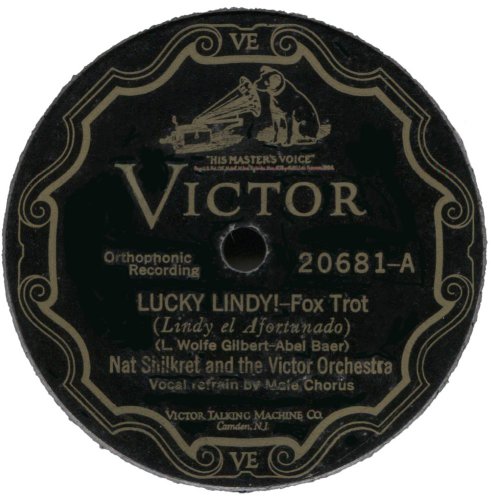
“Lucky Lindy!”
Nat Shilkret And The Victor Orchestra;
Richard Crooks, Lambert Murphy, Frank Luther, Frederic Baer, Fred Patton, vocal
(Victor 20681-A) May 26, 1927
“America Did It Again”
Nat Shilkret And The Victor Orchestra;
Billy Murray, Charles Harrison, James Stanley, Stanley Baughman, Carl Mathieu, vocal
(Victor 20681-B) May 31, 1927
Charles A. Lindbergh’s pioneering solo transatlantic flight from New York to Paris on May 20-21, 1927 was not only that year’s top news story; it also sparked on both sides of the Atlantic a mass cultural celebration of human and technological achievement on a scale not seen again until 1969 when Apollo 11 landed on the moon.
In 1927, the sale of sheet music for the pianos ubiquitous to middle-class parlors was still a driving force and major source of revenue for the music industry. The large Tin Pan Alley music publishing companies were always quick to crank out songs about any topic that captured the public’s imagination.
The Lindbergh flight was no exception; songs commemorating the event were quickly composed and rushed to press. Eventually, over 300 songs related to Lindbergh were submitted to the U.S. Copyright Office.
“Lucky Lindy!” composed by Abel Baer with lyrics by L. Wolfe Gilbert is reported to have been the first of the Lindbergh songs with a copyright date of May 25, 1927, just four days after Lindbergh touched down in Paris. The recording here by Victor’s in-house orchestra, directed by Nat Shilkret, was made the day after the song was copyrighted.
My hunch is that the music publishers and the record labels were probably communicating about forthcoming Lindbergh songs before the composers were even finished writing them.
“America Did It Again,” with words and music by Ted Koehler and Marty Bloom, was recorded by the Shilkret orchestra on May 31, 1927. The fact that the song was not formally copyrighted until June 7 also suggests early collaboration between the publishers and the record labels.
Lindbergh’s flight was definitely a trailblazing achievement. But the same cannot be said for the lyrics of many of the songs that commemorated it.
For whatever reason, there seems to have been a fascination for Charles Lindbergh’s mother. Both of these songs make mention of her as does another famous Lindbergh song, “Lindbergh (The Eagle of the U.S.A.).”
Indeed, the top of the first page of the sheet music for “Lucky Lindy” even features a dedication: “Dedicated to the mother of ‘Lucky Lindy'”
Gee – did they even know much about her? Why not dedicate it to the guy who actually risked his life in a rickety airplane?
The lyrics to “America Did It Again” contain the following passage:
I battled the sky, to do or to die
‘Till I saw that old River Seine
“Hello, Mother” this is your boy
I’m calling from Paris, to tell you with joy
I flew for you, and the Red White and Blue
When I first played the record, I immediately wondered if transatlantic phone calls were even possible at that time. A quick search revealed that the very first transatlantic phone call occurred less than five months earlier, on January 7, 1927, between London and New York.
I don’t know if things would have been set up by late May for such a call to be patched through between London and Paris. But even if they had, it would have been enormously expensive.
Even domestic long-distance calls within the USA at that time were expensive and typically required many minutes for a team of people in multiple cities to patch a call through to its final destination. Occasionally, in early sound films, one will see a scene showing how long-distance calls were placed. The person calling would provide the operator with the name, city, and number of the person they wished to speak with and then disconnect. Once the call was successfully put through – which could take as much as 20 minutes, depending on where the call needed to be routed – the operator would ring the caller back and advise that the other party was on the line.
Presumably, given the apparent fascination with his mother, if Lindbergh had placed such a call using a still novel and extremely expensive technology, that, too, would have made headlines. But, the day after Lindbergh landed, the New York Times ran an article about Mrs. Lindbergh waiting at her home in Detroit for word as to whether or son had successfully landed or perished. No mention at all was made of such a phone call.
I wonder how many people back in 1927 were as skeptical of those lyrics as I was. And I wonder if, when the publishers commissioned such songs, they told the composers, “With so many young people buying records and listening to the radio these days, mothers of grown children have become an increasing percentage of our sheet music buyers—so make sure you mention Lindbergh’s mother!”
While these songs are hardly the best examples of the wonderful music that the era had to offer, I do think recordings about then-current and now-historical events are fun to come across.
